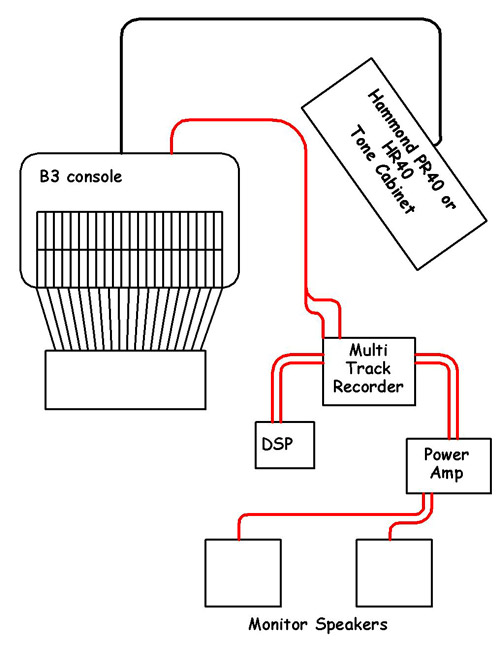RECORDING the Hammond Organ
North Suburban HAMMOND ORGAN Service
Figure 2. This is a typical recording setup uisng a multi-track recorder and also a digital signal processor for securing an excellent result for recording an older Hammond such as a B3 with a Hammond tone cabinet.

This next picture shows the type of setup that we could use to record a typical traditional Hammond, such as a B3 with just a standard Hammond tone cabinet, such as a PR40. Here, we’ll take the console output signal (which is mono) directly from either one of the two “G” terminals in the console (but not both) and also ground which can be any convenient point on the chassis.
We’ll actually split this off so that we can record it on two separate channels in a multi-track recorder, even though, because we are dealing with a mono signal, we could use a standard recorder, either digital audio or tape and be all set. But to be consistent with the general theme of this article, we’ll stick with the use of a multi-track machine.
We’ll also use a digital signal processor (DSP) to generate reverb, as the digital reverb is vastly superior to the older Hammond spring type reverb that would be a part of the PR40 tone cabinet.
The signal that we get from the B3’s console preamp is a mono signal. However, the DSP outputs a true stereo reverb signal and thus we’ll want to record on two tracks in the multi-tracker. In addition to reverb, there are several other things which we could do via DSP to further the stereo effect, but we’ll look at those later. However, an interesting thing can occur here. If we play the final recording back through a good stereo system, we will very likely find that the sound of the recording will be even better than that of the original sound of the B3 playing through the PR40 tone cabinet. The B3 purists will disagree and say that what we are doing is nothing short of a major crime against the Hammond Organ and all that Laurens Hammond stood for, but the end results speak for themselves. Don’t forget, the last B3 was made in 1974. This is 2024, fifty years later. I like to think that there are some major improvements in the audio of today as compared to that of 1974!
If we wanted to get somewhat creative here, we could also set up the DSP to do Leslie simulation, something that many DSPs do quite well. When you are in the same room with a real Leslie, there is a slight but noticeable difference between Leslie simulation and the sound of the real thing. However, in a recording, the difference between the sound of a real Leslie and that of a digital Leslie simulation is much smaller, and a good DSP can do an excellent job. Thus, in this situation where we have an older Hammond playing through a standard Hammond tone cabinet, we can make our recording sound significantly better both by using modern stereo digital reverb and also Leslie simulation. It’s a win/win situation. The artist gets improved results, and the end consumer likewise gets a superior recording.
Back to Page 1. Go to Page 3. Page 2.